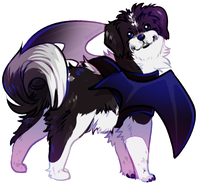Welcome to the 2017 Silky Summer Event: African Adventure!
Some new, very fun genes have been discovered through researcher's hard work completing genome analysis. These genes express in very similar ways to patterns on familiar African mammals, thus they have been named for the animals.
These silkies show the purest form of these newly found genes, and it seems that this affects their character in the slightest way. They tend to be more in touch with their wild instincts, and are a little less receptive to human contact. They will take some patience to tame. It's said that you don't choose them, they choose you.
You will have the month of August to try taming them. At the end of the month, the silkies will go home with their chosen applicant.
You can apply for as many as you want, but may only win one.

- . . . . Viveri
Viveri (vivi) creates a spotted and striped pattern similar to the African civet. The marking is always darker than the base coat and it is covered up by other markings such as white markings and sooty.
- . . . . Quagga
Quagga(ququ) creates a striping pattern similar to the quagga. The marking is always lighter than the base coat. It will express on top of sooty, but will be covered by white markings.
- . . . . Gazella
Gazella(gaga) creates a broad, dark stripe on the silky's side, similar to the Thomson's gazelle. It also expresses with dark eye markings. Gazella marks are always dark. They express under most genes.
- . . . . Okapi
Okapi(okok) creates a striping pattern similar to the Okapi. Okapi markings are always white or off-white. It expresses under most genes.
- . . . . Wilde
Wilde (wilwil) creates a patch of brindling similar to the wildebeest. Wilde markings are always darker than the base coat. It expresses under most genes.









